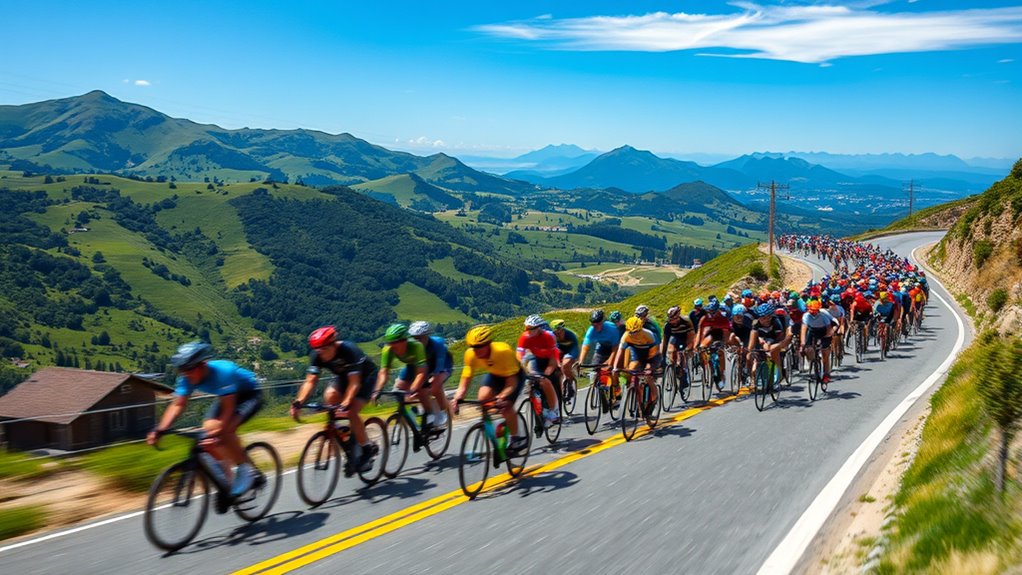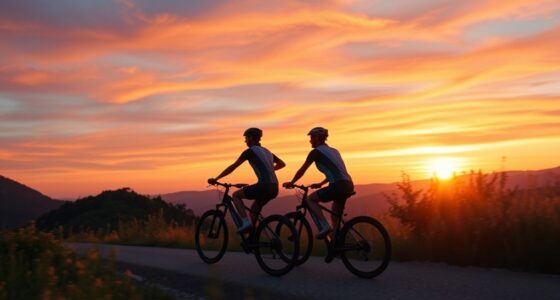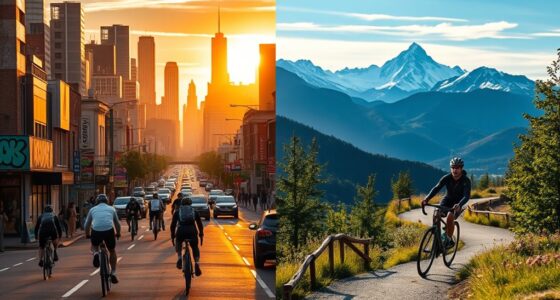Starting with just a 5 km group ride helps build confidence, skills, and a sense of community. As you enjoy these short trips, social bonds grow, encouraging more riders to join and share their experiences. With organized support and leadership, you can gradually increase distances, transforming a casual snowball into a thriving 50 km adventure. Keep exploring, and you’ll discover how to create a supportive environment that keeps every cyclist motivated and engaged.
Key Takeaways
- Gradually increase ride distances, starting from 5 km, to build endurance and confidence for longer group adventures.
- Maintain open communication and shared goals to foster group cohesion as ride distances expand.
- Incorporate social activities and camaraderie during longer rides to strengthen bonds within the cycling community.
- Use structured planning, including route selection and rest stops, to ensure safety and enjoyment on extended rides.
- Promote inclusive practices and proper gear to encourage participation and maintain motivation across all skill levels.
The Power of Starting Small: Why 5 Km Rides Matter
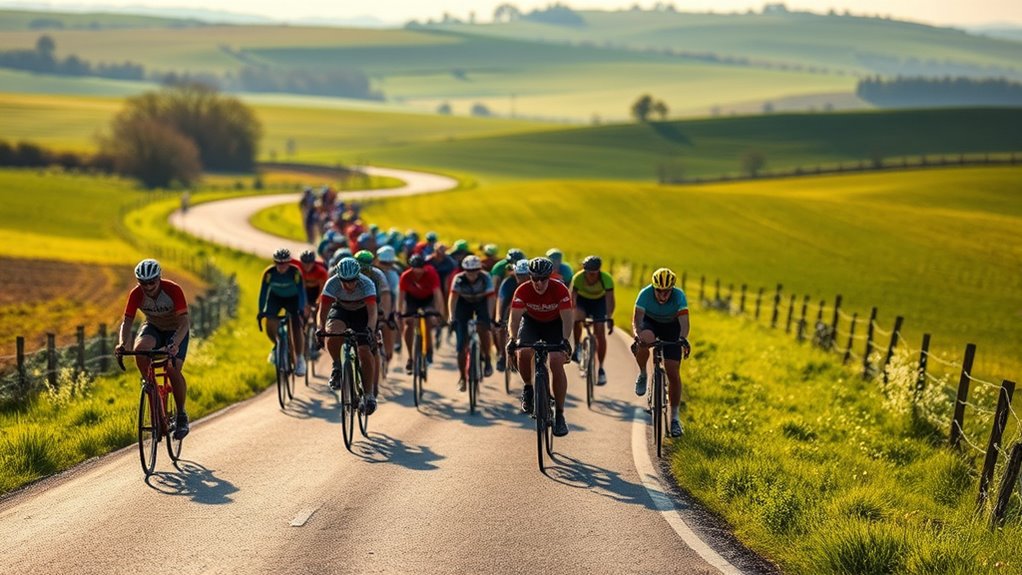
Starting with small rides, like a 5 km trip, can seem modest, but it’s a crucial step toward building confidence and stamina. Whether you’re mountain biking on rugged trails or traversing city streets for urban commuting, short rides help you get comfortable on your bike. These quick trips allow you to focus on technique, safety, and bike handling without feeling overwhelmed. They also give you a sense of achievement, motivating you to tackle longer distances later. For urban commuting, a 5 km ride can be a practical, eco-friendly way to start your day, while mountain biking offers a manageable introduction to off-road adventures. Small rides lay the foundation for increased endurance, making longer rides more enjoyable and less intimidating.
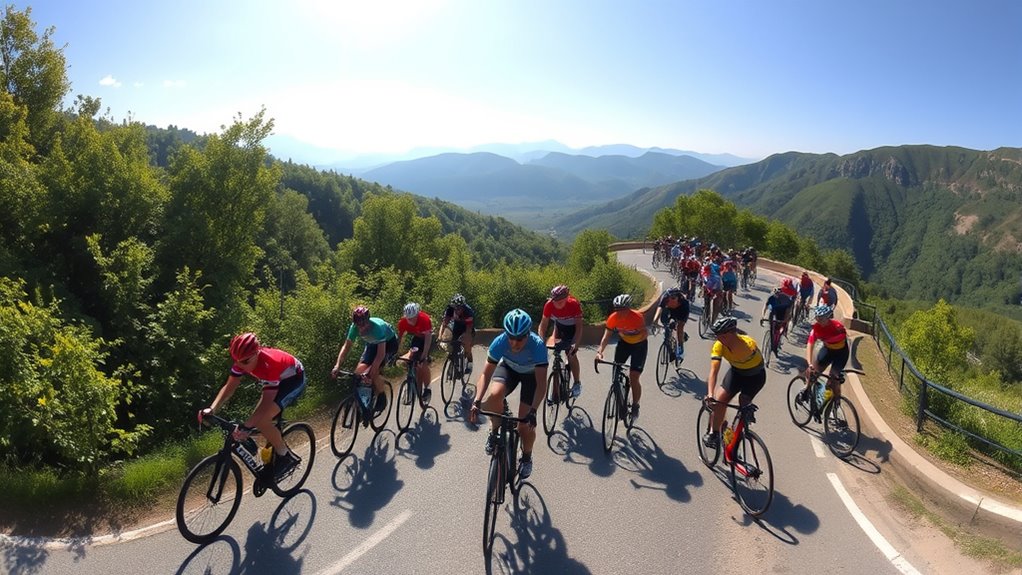
Group rides naturally foster social connections as cyclists share experiences, encourage one another, and work together toward common goals. As you ride, conversations flow, creating bonds beyond the bike. Proper cycling gear boosts confidence and comfort, making it easier to focus on camaraderie. Route planning plays a key role, as choosing scenic or challenging paths encourages teamwork and shared achievement. When everyone’s prepared with the right gear, the ride becomes more enjoyable, promoting interaction and trust. These shared moments, whether steering through a tough climb or cruising through a scenic route, strengthen community. Over time, these connections grow, transforming casual riders into a supportive cycling family. Your involvement in group rides isn’t just about the miles—it’s about building lasting social ties. Additionally, considering the role of projectors in enhancing visual experiences can inspire riders to incorporate multimedia elements into their post-ride gatherings, enriching the communal atmosphere.
Motivational Boosts: Encouraging New Cyclists to Join
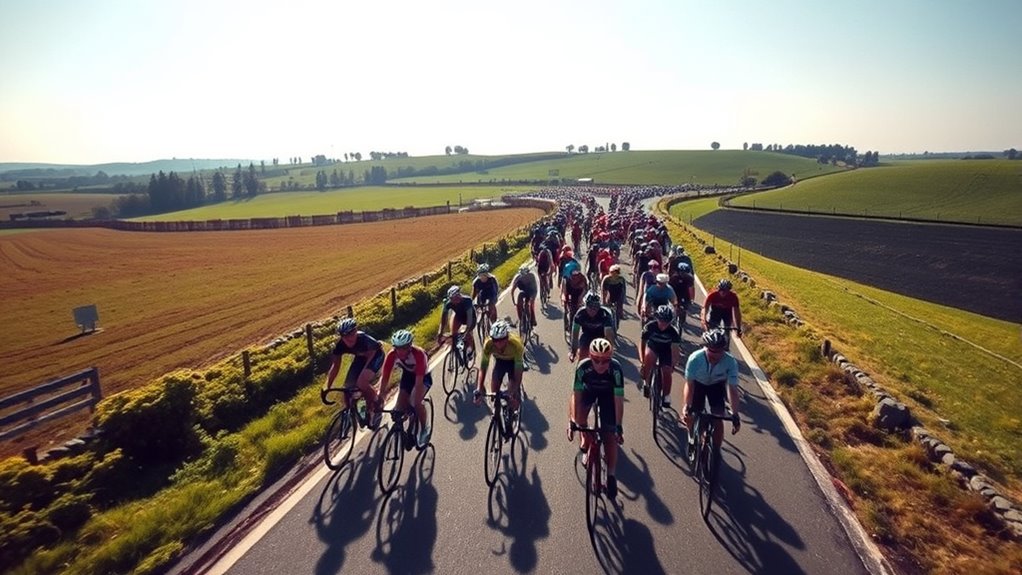
Encouraging new cyclists to join requires highlighting the immediate benefits they’ll experience, such as improved fitness, fresh scenery, and the chance to meet friendly riders. To motivate them, emphasize how group rides boost confidence and make cycling more enjoyable. Suggest starting with comfortable cycling gear to guarantee safety and comfort, which encourages continued participation. Share simple nutrition strategies to help sustain energy during longer rides, making the experience rewarding. Highlight the social aspect, where encouragement from peers creates a supportive environment. Remind newcomers that every ride is a step toward greater endurance and skills. Incorporating bike tuning tips can also enhance performance and boost rider confidence. Additionally, emphasizing the mental health benefits of cycling can motivate new riders by showing how outdoor activity boosts mood and reduces stress. Recognizing the community aspect of cycling can inspire beginners to stay committed and connect with like-minded enthusiasts. By focusing on these motivational boosts, you help new cyclists feel welcomed and excited to join the fun. Their journey from beginners to confident riders begins with these positive, engaging incentives.
Scaling Up: Transitioning From Short to Longer Rides

As you increase ride distances, focus on building endurance together to guarantee everyone stays strong and motivated. Keep communication open to maintain group cohesion, so no one feels left behind or overwhelmed. By supporting each other, you’ll make longer rides enjoyable and sustainable for all. Incorporating reliable electric bike conversion kits can also ease the effort needed for extended distances, making the experience more accessible and enjoyable. Additionally, considering environmental impacts and choosing sustainable practices can help reduce the overall carbon footprint of your group rides.
Building Endurance Together
Moving from short to longer rides requires a gradual approach that builds your endurance without risking burnout or injury. To succeed, focus on consistent pacing and listening to your body. As you increase distance, prioritize group dynamics and cycling etiquette, ensuring smooth communication and respect among riders. This helps prevent fatigue and keeps everyone motivated. Incorporate natural materials such as wooden or fiber-reinforced components into your bike setup to enhance comfort and durability during extended rides. Additionally, paying attention to proper hydration and nutrition is crucial for maintaining energy levels. Proper planning and understanding of market volatility can help you make smarter decisions about your training and equipment investments. Incorporating cycling gear that offers comfort and efficiency can also make longer rides more enjoyable. Regularly monitoring your bike’s maintenance needs ensures optimal performance on extended journeys. Here are some tips:
- Gradually add 10-15% more distance each week
- Maintain a steady pace suited to the group’s collective fitness
- Communicate clearly about stops, pace changes, or issues
- Support each other to foster camaraderie and shared progress
Building endurance together not only enhances your stamina but also deepens group bonds, making longer rides enjoyable and sustainable.
Maintaining Group Cohesion
Moving from short to longer rides can challenge your group’s cohesion, but maintaining clear communication and mutual support makes the process smoother. Make certain everyone’s cycling gear is suitable for extended distances and varying conditions. Good route planning is vital—agree on the route beforehand, considering rest stops and terrain. Keep conversations open during the ride, checking in regularly to prevent anyone from falling behind. Use this simple table to organize your approach:
| Tip | Action | Benefit |
|---|---|---|
| Clear route planning | Map out stops and terrain beforehand | Reduces confusion, builds trust |
| Communication signals | Develop hand signals or cues | Enhances safety and cohesion |
| Support system | Encourage mutual encouragement | Boosts morale and group spirit |
Staying organized and attentive keeps everyone together and motivated.
Creating a Supportive Environment for All Levels
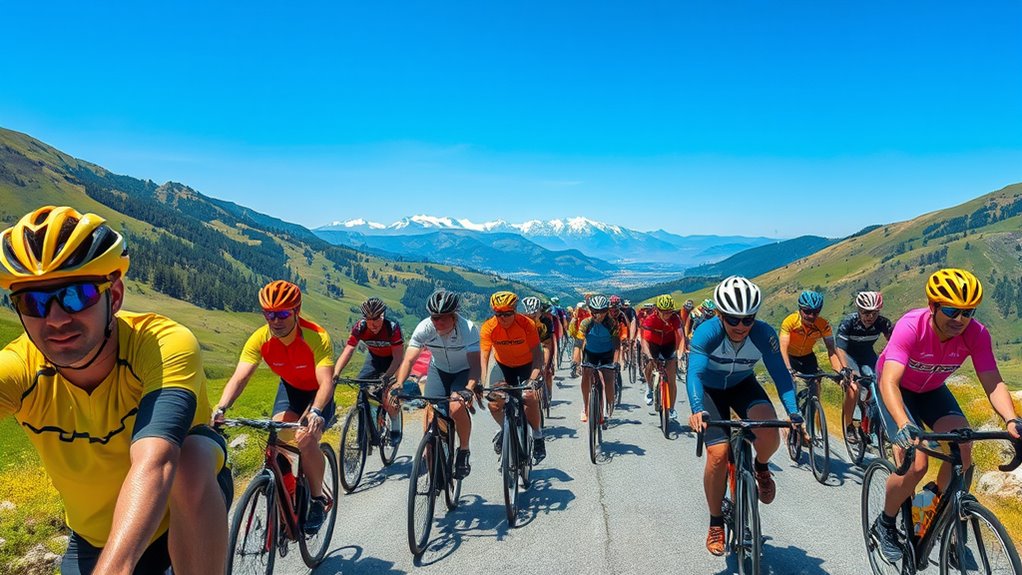
Creating a supportive environment for riders of all levels starts with clear communication and inclusive planning. When you prioritize open dialogue, everyone feels valued and motivated to participate. Focus on accessible route planning that accommodates different paces and distances, ensuring no one feels left behind. Encourage riders to share their cycling gear preferences and needs, promoting comfort and safety. By fostering respect and understanding, you create a welcoming atmosphere that boosts confidence. Implementing user consent management practices helps ensure everyone is comfortable with group activities and communication preferences. Additionally, understanding city dynamics can help tailor rides to suit urban and rural environments, making the experience more enjoyable for all participants. Recognizing the importance of privacy controls can further enhance trust and participation among group members. Developing cultural CQ within the group can also improve communication and foster inclusivity, especially when riding with diverse participants. Incorporating well-being tips related to group activities can help maintain mental and emotional health during extended rides or social interactions.
The Role of Leadership and Organization in Growth
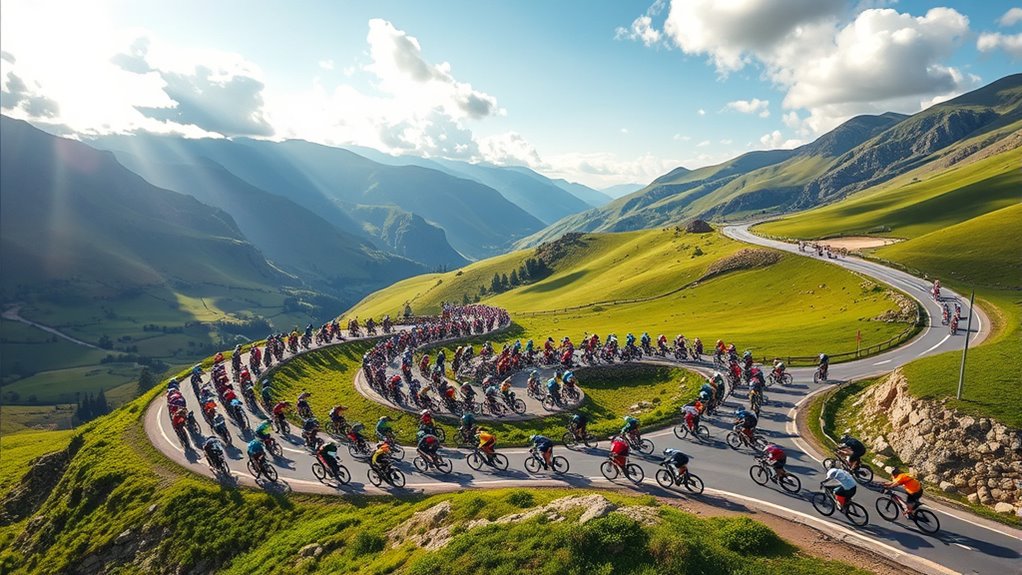
Effective leadership and organization are the backbone of sustainable group growth. Your understanding of leadership dynamics helps you motivate members, foster trust, and create a shared vision. Strong organizational strategies ensure smooth coordination, clear communication, and efficient planning for each ride. As a leader, you set the tone, encourage inclusivity, and adapt to members’ needs, which keeps the group engaged and motivated. Good organization minimizes confusion and logistical issues, allowing riders to focus on enjoying the ride and building connections. When leadership and organization work hand in hand, they create an environment where members feel valued and inspired to participate regularly. Recognizing relationship patterns within your group can further enhance cohesion and understanding among members. Additionally, applying zoning laws principles from local regulations can help establish consistent schedules, making planning easier for everyone. Incorporating group dynamics insights can also improve communication and cooperation, strengthening the group’s foundation as it expands from casual 5 km rides to more ambitious 50 km adventures. This solid foundation is essential as your group expands from casual 5 km rides to more ambitious 50 km adventures.
Sustaining the Momentum: Keeping the Cycling Spirit Alive
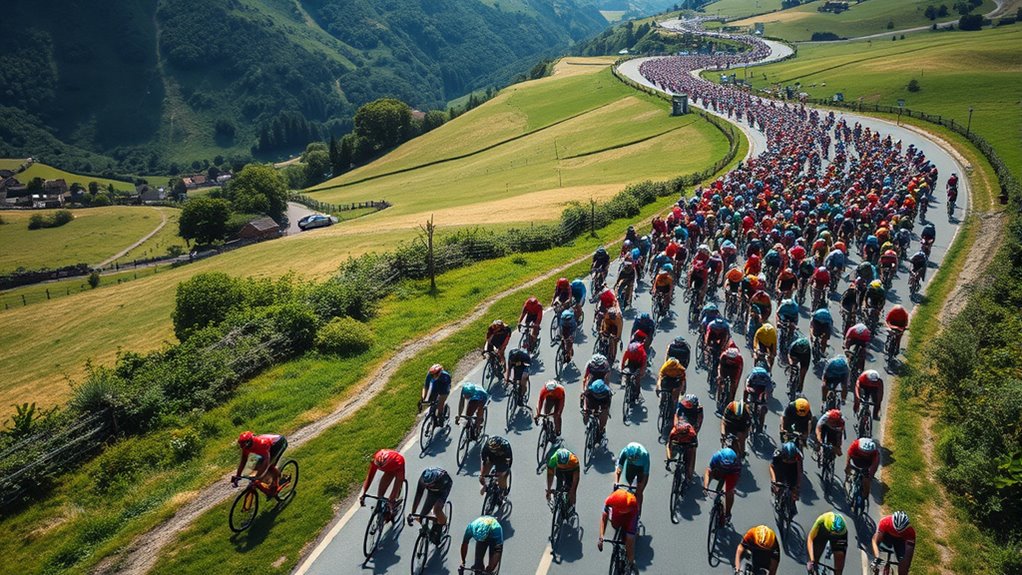
Keeping the cycling spirit alive requires more than just organizing rides; it demands ongoing enthusiasm and engagement from everyone involved. To sustain momentum, focus on fostering community bonds and sharing knowledge. Emphasize the importance of cycling nutrition to keep energy levels high during longer rides. Regular bike maintenance ensures safety and minimizes breakdowns, keeping riders confident. Encourage members to set new goals, like tackling different routes or distances. Celebrate milestones to boost motivation and reinforce camaraderie. Also, incorporate social elements—post-ride chats or coffee meetups—to deepen connections. Utilizing proper equipment and ensuring it is well-maintained can significantly enhance the overall experience. Staying informed about IRA investment strategies can help participants plan for future financial stability, ensuring they can continue enjoying cycling without financial worries. Additionally, understanding the benefits of eye patches can be useful for recovery and refreshment after long rides or travel days. By maintaining a fun, supportive environment, you’ll keep everyone inspired and eager for the next ride, ensuring the social snowball keeps rolling stronger than ever.
Frequently Asked Questions
How Do Group Rides Impact Individual Cycling Performance Over Time?
Group rides positively impact your individual endurance over time by fostering team dynamics that motivate you to push harder. As you ride with others, you naturally increase your stamina and performance, benefiting from shared effort and encouragement. Over repeated rides, this collective environment helps you build strength and confidence, making you a stronger cyclist. The social aspect keeps you engaged and committed, accelerating your progress and enhancing your overall cycling performance.
What Safety Measures Are Essential for Larger Group Rides?
Safety measures for larger group rides are your shield in a bustling parade. You should conduct helmet checks to verify everyone’s gear is secure and comfortable. Route planning is essential; pick wide, well-marked paths and communicate the plan clearly. Designate a lead rider and a sweep, and stay alert for traffic and road hazards. These steps keep the ride smooth and safe, making sure everyone pedals with confidence.
How Can Organizers Effectively Manage Diverse Skill Levels?
You should focus on skill differentiation by grouping riders with similar abilities and planning routes accordingly. Use clear communication strategies, like pre-ride briefings and signage, to inform everyone of the plan and safety tips. Encourage experienced riders to support beginners and foster a positive environment. By actively managing skill levels and maintaining open communication, you guarantee a smooth, enjoyable ride for all participants.
What Are Common Challenges When Scaling From 5 Km to 50 Km Rides?
When scaling from 5 km to 50 km rides, you face challenges like managing group ride logistics and maintaining rider communication. Longer distances require careful planning to guarantee pacing suits everyone, preventing fatigue or frustration. You need clear communication channels, like radios or apps, to coordinate effectively. Balancing diverse skill levels becomes harder, so you must adapt your strategies to keep everyone safe, motivated, and engaged throughout the extended ride.
How Does Group Size Influence Rider Motivation and Retention?
Did you know larger groups can boost rider motivation through stronger group cohesion? As your group grows, members feel more accountable, encouraging consistent participation. However, too many riders might reduce individual attention, risking disengagement. Balancing group size helps foster accountability and camaraderie, keeping riders motivated and committed. Ultimately, a well-sized group enhances the social snowball effect, making long-distance rides more enjoyable and sustainable for everyone involved.
Conclusion
As you lace up your shoes and hit the road, imagine a ripple starting small—your first 5 km ride—that gently expands into a vibrant community stretching 50 km. Each pedal stroke builds connections, fuels motivation, and creates a supportive atmosphere where everyone, from beginners to seasoned cyclists, belongs. Keep riding, keep growing; watch your circle blossom like a blooming trail, turning fleeting moments into lifelong memories on the open road.
